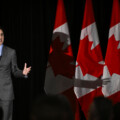Scrapping the federal government’s investment tax credit for carbon capture, utilization, and storage (CCUS) technologies would undercut efforts to reach net-zero greenhouse gas (GHG) emissions by 2050—a goal that Ottawa reaffirmed in November in the COP 26 Glasgow Climate Pact. Yet recently, a group of scientists, academics, and energy system modellers urged just that in an open letter to deputy prime minister Chrystia Freeland.
The letter argues that we should focus on other climate solutions already being implemented to help reduce GHG emissions, such as increased electrification, the wide-scale use of renewable energy, and intensifying energy efficiency. Yet while these are all important tools in mitigating climate change, emissions trajectories show that we cannot limit global warming to 1.5 degrees Celsius—the path we need to be on to meet Canada’s climate goals—without the removal of carbon dioxide (CO2).
Briefly, CCUS technologies capture and remove carbon during power generation and industrial processes and can also remove carbon already emitted into the air. Therefore, this suite of technologies not only prevents the release of CO2 into the atmosphere but can also reduce overall accumulation. The usefulness of these technologies has been recognized by the federal government, and they are currently responsible for capturing and storing at least 4 million tonnes of carbon per year in Canada alone. The 2021 federal budget states that CCUS is the only technology currently available with the potential to generate negative emissions, and it can be a strategic tool as a climate mitigation option.
Yet the group of opponents are still set against its implementation, writing, “We urge you to not introduce the proposed investment tax credit for CCUS because it will constitute a substantial new fossil fuel subsidy.” This is inaccurate for a number of reasons.
First, a subsidy gives money directly to a company, while a tax credit, such as this one, reduces a company’s tax burden. If targeted properly to reduce market distortions and avoid artificially picking winners and losers, a tax credit can incentivize the removal of CO2 from the atmosphere—for example, a refundable tax credit tied to performance. Yes, a refundable tax credit can act as a subsidy when a firm has no taxable income; it also tends to do so with small to mid-size enterprises that likely face larger hurdles to entering the market for CCUS in the first place. But it levels the playing field, removing an advantage that would otherwise go to large established players.
Next, the investment tax credit is not targeted at the oil and gas industry. Its intention, as plainly stated on the federal government’s website, is to “be available for a broad range of CCUS applications across different industrial subsectors (e.g. concrete, plastics, fuels), including blue hydrogen projects and direct air capture projects.” In fact, given what is known so far about eligibility for this tax credit, the oil and gas sector is actually the most restricted in that it is the only sector to currently have a stated exclusion. Going into consultations, it had already been announced that enhanced oil recovery (EOR) projects are not eligible.
This tax credit can make a substantial difference in sectors with hard-to-abate emissions, like steel and cement. In these sectors, currently, there are few options to mitigate CO2 emissions, and CCUS is key. These sectors are significant, releasing 12 percent to 14 percent of global energy system combustion and industrial process CO2 emissions. These sectors are also growing, with global cement demand projected to increase by 12 percent to 23 percent by 2050, and global steel demand by 15 percent to 40 percent.
There are different levels of policy and regulatory frameworks which intersect with the broader conditions necessary for the large-scale deployment of CCUS (such as appropriate storage sites and other technological and ecological factors) to create favourable or unfavourable conditions for such deployment. Different jurisdictions experience different barriers or facilitators to CCUS deployment. Canada boasts abundant geological storage for permanent sequestration, as well as industry expertise and technical capacity, and is already considered a leader in CCUS. We ought to play to our strengths, and remember that the net-zero goal applies to global emissions. Encouraging CCUS is not only in our best interest but with almost 200 signatories to the Glasgow Climate Pact, we also need to consider that coordinated and complementary actions will help us reach the government’s goals.
One of the concerns raised by the group is that the technology is not necessarily available on the time scale we need. Indeed, there are hurdles to large-scale CCUS deployment. But that should not curtail our efforts. Rather, we should focus on how to encourage the private sector to increase its involvement. Indeed, the investment tax credit should be just the beginning.
While the federal government has thus far shown no intention of abandoning the credit, it bears repeating: without CCUS, we will not meet our climate goals.
Recommended for You

The Notebook by Theo Argitis: Carney’s One Big Beautiful Tax Cut, and fresh budget lessons from the U.K.

Ginny Roth: How vacant liberal nationalism left Canada worse off than George Grant even imagined

Crystal Smith and Eva Clayton: Indigenous natural resources development is an efficient, fair, and responsible way to advance economic reconciliation

Peter Menzies: Justin Trudeau’s legislative legacy is still haunting the Liberals



